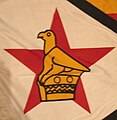Zimbabwe flag
| Zimbabwe flag | |
|---|---|
 |
|
| Vexillological symbol : |
|
| Aspect ratio: | 1: 2 |
| Officially accepted: | April 18, 1980 |
The flag of Zimbabwe was adopted on April 18, 1980. It shows seven bars in the colors green, gold, red, black, red, gold, green and, starting from the shaft, a white, black-rimmed triangle with a red five-pointed star, covered with a golden, nesting bird facing the shaft.
symbolism
- Green represents the country's vegetation and resources
- Gold symbolizes the wealth of minerals
- Red represents the blood that was shed during the struggle for freedom.
- Black represents the country's black population
- The white triangle symbolizes peace and the "way forward"
- The red star stands for internationalism , and reflects the socialist thoughts of the ruling party, but also peace.
- The ' Zimbabwe Bird ' comes from a soapstone depiction found in the ruins of the ancient city of Zimbabwe and represents the national emblem .
The committee that presented the draft flag had not originally planned to include the Zimbabwean bird, which was already found in the previous flag of Zimbabwe-Rhodesia . Only when its uniqueness and history were pointed out was it incorporated into the final design.
Historical flags
Between 1890 and 1923 what is now Zimbabwe was administered by the British South Africa Company . On September 13, 1890, the British Union Jack was set for the first time in Fort Salisbury (today's Harare ) . From 1892 the company's flag, a Union Jack, was used with a lion with an elephant's tusk in its paw and the initials BSAC in the center.
In 1923, Southern Rhodesia became a self-governing colony. From this point on, a typical British colonial flag was used: dark blue with the Union Jack in the canton (top, left corner) and the coat of arms of the colony. The coat of arms showed a leaping, red lion between two thistle flowers on a white background and a gold pickaxe on a green background.
Between 1953 and 1963, Southern Rhodesia was part of the Federation of Rhodesia and Nyasaland, together with Northern Rhodesia (today: Zambia ) and Nyasaland ( Malawi ) . The new coat of arms showed a golden, rising sun on a blue background for Nyassaland, the red lion for Southern Rhodesia and silver waves on a black background for Northern Rhodesia, which symbolized the Victoria Falls. The federation collapsed on December 31, 1963 when Zambia and Malawi gained independence from Great Britain.
1: 2 ? Union Jack (1890-1892)

1: 2 ? British South Africa Company Flag (1892-1923)

1: 2 ? Flag of Southern Rhodesia (1923–1953)

1: 2 ? Flag of the Federation of Rhodesia and Nyassaland

From April 8, 1964 to November 11, 1968, Southern Rhodesia, which remained in colonial ownership, used a light blue version of the old colonial flag from 1923.
Southern Rhodesia unilaterally declared its independence from Great Britain in 1965 and, as the Republic of Rhodesia, had a green, white and green tricolor flag from November 11, 1968 , with the national coat of arms with the Latin saying “Sit Nomine Digna” ( May (Rhodesia) of this name in the middle be worthy ). The green comes from the use of the color by various sports teams, making it a national color. It also pointed to agriculture as the foundation of the land.
On June 1, 1979, a transitional government under Bishop Abel Muzorewa was formed to end the civil war and the state of Zimbabwe-Rhodesia was proclaimed. The flag of Zimbabwe-Rhodesia had a vertical black stripe with the Zimbabwean bird on the mast side, next to it a thin, vertical, white stripe and three horizontal red-white-green. It was designed by Flight Lieutenant Cedric Herbert of the Rhodesian Air Force , who was a member of the Rhodesian Heraldry & Genealogy Society . Black symbolizes the achievements of the majority government in the country, red stands for the struggle for independence, yellow for the mineral resources and green for agriculture and the natural wealth of the country. The white, vertical stripe represents the white, European population, while the white, horizontal stripe represents peace.
In December 1979, Rhodesia was declared a British colony again and therefore led the Union Jack until April 18, 1980. On that day, Rhodesia officially gained independence as Zimbabwe.
1: 2 ? Flag of (Southern) Rhodesia (1964–1968)

1: 2 ? Flag of Rhodesia (1968–1979)

1: 2 ? Flag of Zimbabwe-Rhodesia (June-December 1979)

1: 2 ? Union Jack (December 1979-April 1980)

More historical flags
The Southern Rhodesian Air Force was formed in 1947. It used the symbol of the British Royal Air Force and three horizontal stripes of green, yellow and green on a white background. During the federation 1953-1963 one used the flag of the Royal Air Force with three spearheads in the red disk.
Former President Robert Mugabe used a presidential flag from 1987 to around 1991, but it no longer appears.
 ? Southern Rhodesian Air Force (1947-1953)
? Southern Rhodesian Air Force (1947-1953)
 ? Rhodesian Air Force (1953-1963)
? Rhodesian Air Force (1953-1963)
 ? Presidential flag 1987-1991
? Presidential flag 1987-1991
Municipal flags
Political flags
The ZANU-PF has long been under the leadership of the former president, Robert Mugabe. It emerged from the merger of the Zimbabwe African National Union ZANU with the Zimbabwe African People's Union ZAPU. The Movement for Democratic Change MDC is the main opposition party in Zimbabwe.
See also
Individual evidence
- ^ Whitney Smith , Ottfried Neubecker : coats of arms and flags of all nations. Battenberg, Munich 1980, ISBN 3-87045-183-1 .
Web links
- Flags of the World - Zimbabwe (English)

















